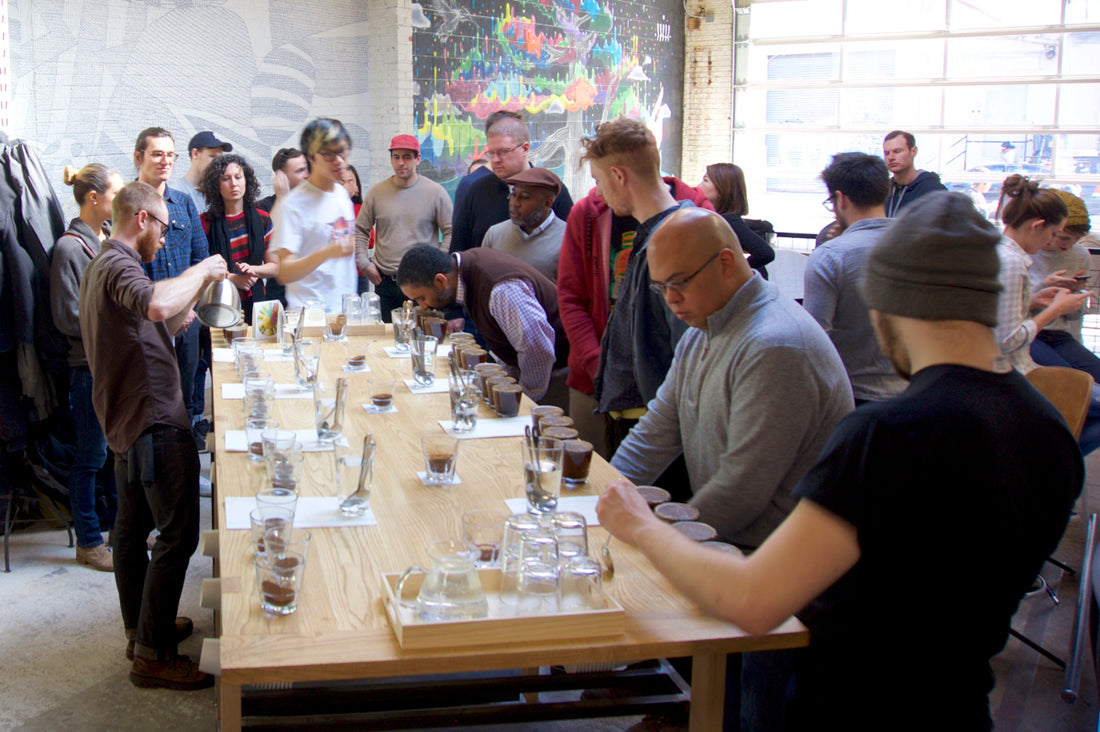
How To Scale Your Coffee Shop with Organic Chaos - Ep. 4
Share
For episode 4 of our podcast, we speak with Jim Osborne and Lanny Huang from City of Saints Coffee. This episode should be of particular interest to baristas, roasters, and coffee shop owners. We learn about how City of Saints differentiates itself by making each of its three locations unique. We get some tips on how to be a better barista, store design, and get into the nuts and bolts of roasting. A few of the highlights from our conversation have been included below.
Also, http://cityofsaintscoffee.com is now live, and you can save 10% off your first order with coupon code "angelscup". The Ethiopia Misty Valley was the most popular coffee as voted on by our coffee tasting meet up group!



Podcast Highlights
Jim - Head Roaster From a coffee perspective, really engaging the baristas that utilize these coffees and really engaging the customers that they speak with and not deciding that we already know how a coffee's going to taste best or which coffee is going to be liked the most. If our baristas are heavily favoring something and they tell us our customers are heavily favoring something as well, I'm 20 feet behind the bar and I'll take that into consideration as the coffee evolves in our lineup. Not deciding what's going to land where on a menu before you've actually tried it out and engaged in a little bit of discussion is something that I am very dedicated to and hope that as we grow, we're able to maintain that. We talk to each other. We make sure that if something's going wrong, or maybe something isn't going wrong but someone feels like things can be going in a stronger direction. We don't let that fester until it becomes a huge problem. It's something that challenges companies as they grow. Right now we're in a really good place to try to make that communication and that collaboration part of our foundation that stays no matter how big the game gets. Most roasters want to do a fairly transparent representation of what they think makes that coffee special. Depending on what niche that coffee's going to fill in your menu, you can manipulate that profile more or less. But one thing I like to do is roast a coffee a few different ways, and if the coffees good every way, don't thank the roaster, thank the farmer and the bean. Becoming a skilled roaster does require a lot of experimentation and and lot of education and a good palate. I of course don't want to discredit what I do or what my peers do. But I think that when we're tasting the best coffees we've ever tasted the roaster is a very important part but not necessarily the point where we should stop thinking about it. There is a common misconception that what happens from first crack to the end is really what it's all about and the rest is just a recipe. They way you distribute the different chemical reactions happening before first crack can dramatically change the character of the cup in terms of sweetness, body, and acidity. I'm sure a lot of us have tried coffee that tasted grassy, or like peanut shells, or maybe a little papery. Frequently what's happening there is the coffee has been dried out to quickly, it hasn't become soluble enough for water to extract enough sweetness out of it. Lanny - Head Barista City of Saints has three locations and they all look really different. What's really interesting about us is that where the stores have ended up popping up, they've developed alongside those neighborhoods. If you think about coffee's role in general, it does need to adapt to different modes of consumption. For me as a service person, having the flexibility to respond directly to what people want, that's the most gratifying thing we offer. As a barista, sometimes you only get 30 seconds to say something, and so when it comes to designing cafes or a coffee program, you have these tiny little bits of data. Maybe it's even a facial expression as someone drinks their coffee, and you have to be ready for those cues. Because people come to coffee from so many different directions, they have this expectation set of what they should taste. My general policy is to be as kind and as open as possible. What you have to do is take that as an opportunity to start that conversation. Can I offer you something else on our menu? Being a good barista is being prepared for those instances. Every cafe is basically the same in that you walk through the door, you order a product that you expect to exist. The nuts and bolts of the cafe experience is the same across every single cafe you walk into. When it comes to putting thought into the details, everything about what differentiates cafes is the details. It's all about those little details about your experience. I spend a ton of time thinking about how to make the ordering process as simple as possible. I just want the communication to be simple, I want the menu to be intuitive. I want all the information to be available, but also if you're not interested in information, if you just want to walk up to the counter and say "coffee", I want our baristas to be able to say "sure", and that's the beginning and end of it. Order here signs are so silly, if it's not obvious where to order, the first thing you do is going to be messed up. I spend a lot of time thinking about those little things.


